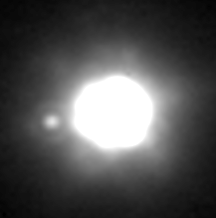762 Pulcova

762 Pulcova and satellite as seen with adaptive optics in 2000
|
|
| Discovery | |
|---|---|
| Discovered by | G. N. Neujmin |
| Discovery date | 3 September 1913 |
| Designations | |
| 1913 SQ | |
| Main belt | |
| Orbital characteristics | |
| Epoch 31 July 2016 (JD 2457600.5) | |
| Uncertainty parameter 0 | |
| Observation arc | 100.08 yr (36553 d) |
| Aphelion | 3.4801 AU (520.62 Gm) (Q) |
| Perihelion | 2.8291 AU (423.23 Gm) (q) |
| 3.1546 AU (471.92 Gm) (a) | |
| Eccentricity | 0.10319 (e) |
| 5.60 yr (2046.5 d) | |
| 348.62° (M) | |
| 0° 10m 33.276s / day (n) | |
| Inclination | 13.089° (i) |
| 305.76° (Ω) | |
| 189.54° (ω) | |
| Known satellites | S/2000 (762) 1 |
| Earth MOID | 1.84297 AU (275.704 Gm) |
| Jupiter MOID | 1.60162 AU (239.599 Gm) |
| Jupiter Tisserand parameter | 3.158 |
| Physical characteristics | |
|
Mean radius
|
68.54±1.6 km |
| Mass | 1.40×1018 kg |
|
Mean density
|
0.90 g/cm3 |
| 5.839 h (0.2433 d) | |
|
Sidereal rotation period
|
5.839 hr |
| 0.0458±0.002 | |
| 11.93 to 14.79 | |
| 8.28 | |
762 Pulcova is a main-belt asteroid. It was discovered by Grigoriy N. Neujmin in 1913, and is named after Pulkovo Observatory, near Saint Petersburg. Pulcova is 137 km in diameter, and is a C-type asteroid, which means that it is dark in colouring with a carbonate composition.
Photometric observations of this asteroid from Leura, Australia during 2006 gave a light curve with a period of 5.8403 ± 0.0005 hours and a brightness variation of 0.20 ± 0.02 in magnitude. This result is in agreement with previous studies.
On February 22, 2000, astronomers at the Canada-France-Hawaii Telescope on Mauna Kea, Hawaii, discovered a small, 15-km moon (roughly a 10th the size of the primary) orbiting Pulcova at a distance of 800 km. Its orbital period is 4 days. The satellite is about 4 magnitudes fainter than the primary. It was one of the first asteroid moons to be identified.
In the year 2000, Merline estimated Pulcova to have a density of 1.8 g/cm³, which would make it more dense than the trinary asteroid 45 Eugenia, and binary 90 Antiope. But estimates by Marchis in 2008 suggest a density of only 0.90 g/cm³, suggesting it may be a loosely packed rubble pile, not a monolithic object.
...
Wikipedia
